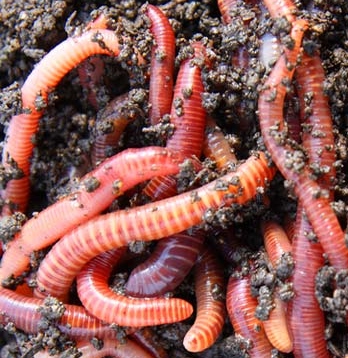Active red worms: Help plants thrive
Red Wigglers: The Secret to Eco-Friendly Composting
Red wigglers, scientifically referred to as Eisenia fetida, play a crucial function in lasting composting practices, providing a natural service to lose management. These worms not just take in organic products but additionally transform them right into valuable vermicompost, enriching dirt health and promoting ecological balance. As metropolitan areas encounter increasing waste difficulties, understanding the advantages and appropriate treatment of these microorganisms becomes crucial for both garden enthusiasts and environmentalists alike. What details steps can individuals require to harness their prospective efficiently?
What Are Red Wigglers?
Although many individuals know with earthworms, red wigglers (Eisenia fetida) are a specific varieties that play a vital duty in composting. Native to Europe, they have adjusted well to a range of environments, particularly in decaying raw material. Unlike common garden worms, red wigglers grow in abundant, wet settings, making them perfect for composting systems.
(red wigglers)These worms are characterized by their reddish-brown coloration and elongated bodies, usually measuring between 3 to 4 inches in length. Red wigglers are epigeic worms, indicating they live near the dirt surface and prey on rotting natural product. Their high reproductive rate allows populaces to expand quickly under optimum problems, with the ability to increase in number every couple of months.
Red wigglers possess an unique digestive system that allows them to break down natural waste effectively. Their lasting nature makes red wigglers a useful property in green composting techniques.
Benefits of Utilizing Red Wigglers
Making use of red wigglers in composting systems supplies various benefits that improve both the effectiveness of waste decomposition and the quality of the resulting garden compost. These earthworms, medically known as Eisenia fetida, are renowned for their remarkable capacity to take in organic waste, transforming it into nutrient-rich vermicompost at an impressive rate. Their rapid digestion process speeds up the malfunction of kitchen scraps and yard waste, significantly reducing the moment required for composting.
In enhancement to their efficiency, red wigglers add to boosted dirt framework and fertility. The vermicast created by red wigglers is abundant in vital nutrients, advantageous microbes, and humic acids, every one of which improve soil health and promote plant growth. This nutrient-dense garden compost assists preserve moisture and boosts aeration in the dirt, fostering a thriving community for plants.
In addition, making use of red wigglers for composting decreases garbage dump waste, adding to a much more sustainable waste management system. By diverting natural materials from land fills, composting with red wigglers reduces greenhouse gas exhausts, making it an environment-friendly selection for environmentally aware people and areas. In general, red wigglers give an efficient and sustainable solution for composting.
Establishing Your Worm Container
Producing a worm bin is a simple process that requires careful consideration of materials and problems to make sure a flourishing setting for red wigglers. Begin by choosing a suitable container, which can be a plastic bin or wooden box, with an ability of at least 10 gallons for reliable composting. Ensure the container has appropriate ventilation by piercing tiny holes in the lid and sides to allow air movement.
Next, prepare the bedding, which is vital for preserving moisture and providing an environment for the worms. Suitable products include shredded paper, cardboard, coconut coir, or peat moss. Go for a bed linen depth of about 4-6 inches, ensuring it is damp but not overly damp.
It is very important to maintain the right temperature for your worm bin, ideally in between 55 ° F and 77 ° F(13 ° C and 25 ° C) Position the container in a shaded area to avoid overheating. In addition, keep the container away from direct sunshine and extreme climate condition to safeguard the worms.
Feeding Your Red Wigglers
Feeding your red wigglers is a critical element of successful worm composting, as it directly impacts their wellness and the performance of your composting system - red wigglers. Red wigglers flourish on a well-balanced diet consisting primarily of organic waste materials.
(red wiggler compost bin)To ensure optimal feeding, it is necessary to present food gradually. Start with tiny amounts to permit the worms to consume the product completely prior to including more. This method stops overfeeding, which can result in anaerobic conditions and adversely impact worm health and wellness. Monitor the food disintegration procedure and adjust the quantity based upon just how quickly the worms are refining the waste.

Keeping Your Worm Compost System
A properly maintained worm compost system is necessary for taking full advantage advice of the efficiency and longevity of your composting efforts. Routine monitoring of moisture levels is important, as red wigglers grow in a damp atmosphere, preferably around 70% humidity. If the bed linen comes to be also completely dry, gently haze it with water; alternatively, if it becomes overly wet, add dry bedding such as shredded newspaper or cardboard to absorb excess moisture.
Temperature control is likewise essential. Red wigglers choose temperatures in between 55 ° F and 77 ° F(13 ° C to 25 ° C) If temperature levels surpass 85 ° F(29 ° C), the worms may become stressed or die. Guarantee your garden compost system is maintained in a shaded, ventilated location to stop overheating.
Furthermore, check for any type of undesirable smells, which might show an inequality in the system. On a regular basis freshening the garden compost by delicately turning it will help preserve proper air flow and prevent anaerobic problems. Lastly, keep track of the worm populace and their activity; a flourishing populace shows a healthy atmosphere. By following these upkeep practices, you can guarantee a productive and lasting worm composting system that efficiently recycles natural waste.

Conclusion
In verdict, red wigglers play a crucial role in eco-friendly composting by properly transforming natural waste right into beneficial vermicompost. Embracing the use of red wigglers represents a functional technique to boosting ecological sustainability and cultivating healthier ecosystems.